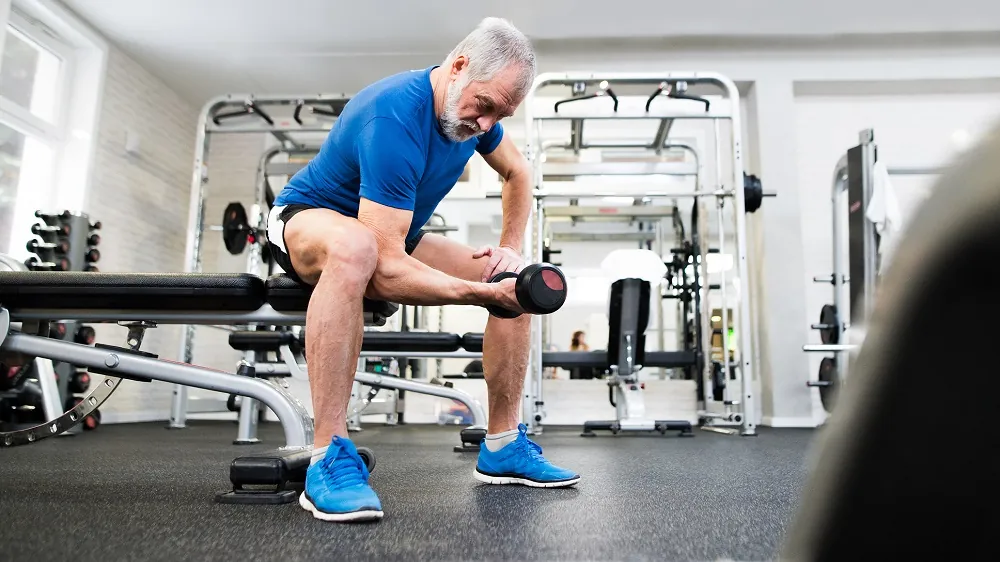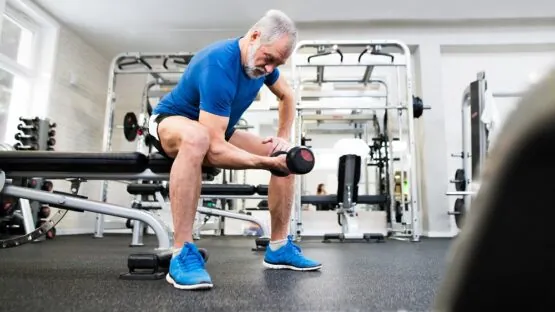A new review summarizes our knowledge about lifestyle interventions, such as exercise, healthy diet, and good sleep, that can possibly reduce cellular senescence [1].
What do we do with a senescent cell?

Read More
Senescent cells play a complex role. In some contexts, such as early organismal development and wound healing, senescence plays a beneficial role. However, with age, the excessive accumulation of senescent cells has been reported to cause harm by reducing regenerative capacity and increasing inflammation. Cellular senescence is also highly heterogeneous across cell and tissue types, which makes studying it harder.
Targeting senescent cells in an aging organism has shown many benefits in preclinical studies. Numerous clinical trials are currently underway, featuring compounds that clear senescent cells out (senolytics) or make them less harmful (senomorphics). Some phytochemicals supposedly have senolytic activity, such as fisetin, which is available as a supplement. The budding field of senolytic cosmetics is also worth mentioning, although the actual evidence behind such products might be thin.
Run from senescence (but not too fast)
Another option is lifestyle interventions. Preclinical and clinical studies have shown promising results, which now have been summarized in a new review published in the Biomedical Journal. The authors start with exercise, which is a powerful anti-aging intervention when done right. In numerous rodent studies, various types of exercise have shown senolytic effects in multiple organs and tissues, including heart, liver, muscle, kidney, and fat [2]. Many times, those effects were beneficial for the animals’ health [3].
However, the authors note that “the relationship between exercise and senescence is not straightforward. For instance, exercise-induced senescence of fibro-adipogenic progenitor cells is beneficial for inducing regeneration of muscle cells following exercise” [4]. It is also known that too much exercise can be harmful, including in the context of cellular senescence. One study found that extremely intensive swimming caused senescence in the hippocampus and impaired memory in rats [5].
There are human studies showing that exercise lowers markers of senescence. For example, endurance running was found to effectively block the age-related increase in senescence [6]. Another study suggests that resistance training increases the clearance of senescent cells, even in young healthy adults [7].
Have another helping of senolytics
Diet can also be important in the context of cellular senescence. Obesity is a major driver of inflammation and cellular senescence, as is hyperglycemia [8]. High-glycemic diets lead to increased production of advanced glycation end-products (AGEs), which have been shown to induce cellular senescence in rats.
Conversely, caloric restriction, another powerful anti-aging intervention, can reduce senescent cell burden [9]. As for intermittent fasting, which is becoming increasingly popular, the researchers mention a study that found a trend towards lower cellular senescence in humans, although those results did not quite reach statistical significance [10].
Dietary protein has always been a matter of debate. Many studies suggest that high protein consumption, especially from animal sources, can be detrimental, while others have found that at least older people should consume more protein to slow their muscle mass loss. In the context of cellular senescence, one study found that in mice, high dietary protein and fat exacerbate hepatic senescence and the SASP [11]. High-fat diets are more clearly linked to cellular senescence [12], although this can be due to excess caloric intake resulting in obesity.
Other than fisetin, the phytochemicals that have shown promise against cellular senescence include quercetin, piperlongumine, berberine, and epigallocatechin gallate (EGCG), which is abundant in green tea.
Probiotics can apparently slow the accumulation of senescence cells [13]. Some known senolytics, such as quercetin, have been found to alter gut microbiota [14]. This, according to the authors, might explain part of their senolytic effects.
Sleep on it
The authors also discuss sleep quality, which is increasingly recognized as an important pillar of healthy lifespan. While the research on the relationship between sleep and cellular senescence is scarce, it mostly points in one direction. In a mouse model, chronic sleep deprivation led to the accumulation of the senescence marker p16 [15]. Participants in the Women’s Health Initiative study who reported sleep fragmentation and insomnia had higher levels of late-differentiated T cells, which might be senescent or near senescent [16]. Sleep deprivation was also shown to upregulate genes related to SASP and p16 in older adults [17].
This succinct review suggests that while we wait for powerful senolytics to be developed, well-known lifestyle interventions and some phytomolecules that are generally considered safe might slow harmful senescent cell accumulation. However, more research is needed, especially in understudied fields such as senescence and sleep quality.
Literature
[1] Martel, J., Ojcius, D. M., & Young, J. D. (2023). Lifestyle interventions to delay senescence. Biomedical Journal, 100676.
[2] Zhang, X., Englund, D. A., Aversa, Z., Jachim, S. K., White, T. A., & LeBrasseur, N. K. (2022). Exercise counters the age-related accumulation of senescent cells. Exercise and sport sciences reviews, 50(4), 213.
[3] Bao, C., Yang, Z., Li, Q., Cai, Q., Li, H., & Shu, B. (2020). Aerobic endurance exercise ameliorates renal vascular sclerosis in aged mice by regulating PI3K/AKT/mTOR signaling pathway. DNA and cell biology, 39(2), 310-320.
[4] Saito, Y., Chikenji, T. S., Matsumura, T., Nakano, M., & Fujimiya, M. (2020). Exercise enhances skeletal muscle regeneration by promoting senescence in fibro-adipogenic progenitors. Nature communications, 11(1), 889.Chicago
[5] Liu, B., Liu, W., Liu, P., Liu, X., Song, X., Hayashi, T., … & Ikejima, T. (2019). Silibinin alleviates the learning and memory defects in overtrained rats accompanying reduced neuronal apoptosis and senescence. Neurochemical research, 44, 1818-1829.
[6] Demaria, M., Bertozzi, B., Veronese, N., Spelta, F., Cava, E., Tosti, V., … & Fontana, L. (2023). Long-term intensive endurance exercise training is associated to reduced markers of cellular senescence in the colon mucosa of older adults. npj Aging, 9(1), 3.
[7] Yang, C., Jiao, Y., Wei, B., Yang, Z., Wu, J. F., Jensen, J., … & Kuo, C. H. (2018). Aged cells in human skeletal muscle after resistance exercise. Aging (Albany NY), 10(6), 1356.
[8] Narasimhan, A., Flores, R. R., Camell, C. D., Bernlohr, D. A., Robbins, P. D., & Niedernhofer, L. J. (2022). Cellular Senescence in Obesity and Associated Complications: a New Therapeutic Target. Current diabetes reports, 22(11), 537-548.
[9] Fontana, L., Mitchell, S. E., Wang, B., Tosti, V., van Vliet, T., Veronese, N., … & Demaria, M. (2018). The effects of graded caloric restriction: XII. Comparison of mouse to human impact on cellular senescence in the colon. Aging Cell, 17(3), e12746.
[10] Erlangga, Z., Ghashang, S. K., Hamdan, I., Melk, A., Gutenbrunner, C., & Nugraha, B. (2023). The effect of prolonged intermittent fasting on autophagy, inflammasome and senescence genes expressions: An exploratory study in healthy young males. Human Nutrition & Metabolism, 32, 200189.Chicago
[11] Nehme, J., Yang, D., Altulea, A., Varela-Eirin, M., Wang, L., Hu, S., … & Demaria, M. (2023). High dietary protein and fat contents exacerbate hepatic senescence and SASP in mice. The FEBS Journal, 290(5), 1340-1347.
[12] Sone, H., & Kagawa, Y. (2005). Pancreatic beta cell senescence contributes to the pathogenesis of type 2 diabetes in high-fat diet-induced diabetic mice. Diabetologia, 48, 58-67.
[13] Boyajian, J. L., Ghebretatios, M., Schaly, S., Islam, P., & Prakash, S. (2021). Microbiome and human aging: probiotic and prebiotic potentials in longevity, skin health and cellular senescence. Nutrients, 13(12), 4550.
[14] Tamura, M., Hoshi, C., Kobori, M., Takahashi, S., Tomita, J., Nishimura, M., & Nishihira, J. (2017). Quercetin metabolism by fecal microbiota from healthy elderly human subjects. PLoS One, 12(11), e0188271.
[15] Carreras, A., Zhang, S. X., Peris, E., Qiao, Z., Gileles-Hillel, A., Li, R. C., … & Gozal, D. (2014). Chronic sleep fragmentation induces endothelial dysfunction and structural vascular changes in mice. Sleep, 37(11), 1817-1824.
[16] Carroll, J. E., Irwin, M. R., Levine, M., Seeman, T. E., Absher, D., Assimes, T., & Horvath, S. (2017). Epigenetic aging and immune senescence in women with insomnia symptoms: findings from the Women’s Health Initiative Study. Biological psychiatry, 81(2), 136-144.
[17] Carroll, J. E., Cole, S. W., Seeman, T. E., Breen, E. C., Witarama, T., Arevalo, J. M., … & Irwin, M. R. (2016). Partial sleep deprivation activates the DNA damage response (DDR) and the senescence-associated secretory phenotype (SASP) in aged adult humans. Brain, behavior, and immunity, 51, 223-229.




